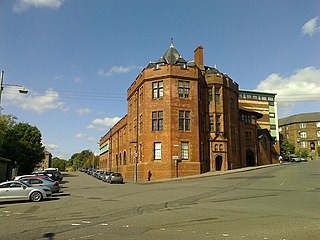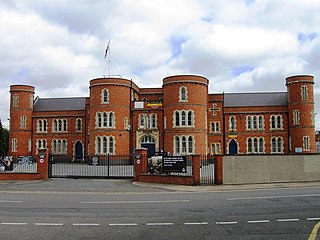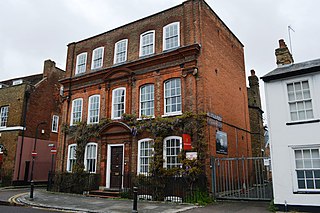
The Worcestershire Regiment was a line infantry regiment in the British Army, formed in 1881 under the Childers Reforms by the amalgamation of the 29th (Worcestershire) Regiment of Foot and the 36th (Herefordshire) Regiment of Foot. The regiment fought in many conflicts, including both the First and Second World Wars, until 1970, when it was amalgamated with the Sherwood Foresters to form the Worcestershire and Sherwood Foresters Regiment. In September 2007, the regiment amalgamated with the Cheshire Regiment and the Staffordshire Regiment to form the Mercian Regiment.

The Leicestershire and Derbyshire Yeomanry was formed in 1957 as a regiment of the British Army. It evolved to become part of the Royal Yeomanry. Its lineage is maintained by the E Squadron of that regiment.

The Derby Road drill hall is a former military installation in Nottingham, Nottinghamshire. It is a Grade II listed building.

The Yorkhill Street drill hall is a former military installation in Glasgow.

The Bridge Street drill hall is a former military installation in Macclesfield, Cheshire.

Caernarfon Barracks is a military installation in Caernarfon, Wales.

The Back Lane drill hall is a former military installation in Newtown, Wales.

The Honey Street drill hall is a former military installation in Bodmin, Cornwall.

The St Paul's Street drill hall is a military installation in Huddersfield, West Yorkshire. It is a Grade II listed building.

The Carlton Place drill hall is a military installation in Southampton, Hampshire.

The Drill Hall Road Army Reserve Centre is a military installation in Newport, Isle of Wight.

The Clare Street drill hall is a military installation in Northampton, Northamptonshire. It is a Grade II listed building.

The Longden Coleham drill hall is a former military installation in Shrewsbury, Shropshire.

The Horninglow Street drill hall is a former military installation in Burton upon Trent. It is a Grade II listed building.

Yeomanry House is a military installation in Hertford. It is a Grade II* listed building.

The Northgate Street drill hall is a former military installation in Warwick.
The 4th (Volunteer) Battalion, The Worcestershire and Sherwood Foresters was a former territorial infantry battalion that existed for a short time towards the end of the Cold War. Following reductions to the Territorial Army (TA) in 1992, the battalion was disbanded with elements helping to form RHQ & HQ Sqn of 37 Signal Regiment, and 96 Signal Squadron. This squadron was then reduced to a signal troop in 2009, but continues to exist as part of 48 Signal Squadron.
The Light Infantry and Mercian Volunteers was a short-lived infantry regiment of the British Army, in existence from 1971 to 1975.
The Mercian Volunteers was a Territorial Army infantry regiment of the British Army, in existence from 1967 to 1988. Upon formation, it consisted of a singular battalion, however it later raised a second in 1975.

The Worcestershire Rifles was a volunteer, part-time unit of the British Army based in the county of Worcestershire which had a long, yet split history in two units before merging into the larger Worcestershire Regiment. Following active service in both World Wars, during which its strength was doubled into three battalions, the unit was reduced to a company, and later expanded to two companies. Following reductions in the early 21st century, the two companies were merged and later reduced to a platoon in 2006. Today, the regiment's lineage is continued in the anti-tank platoon of the 4th Battalion, Mercian Regiment, still based in Kidderminster where the first volunteers had formed.


















